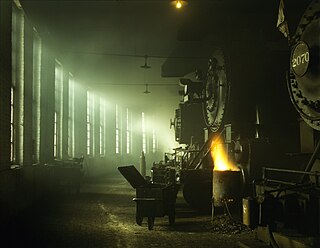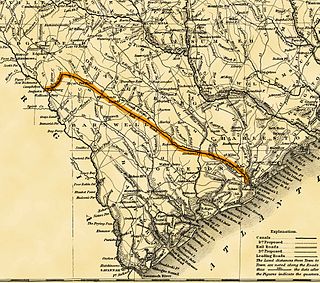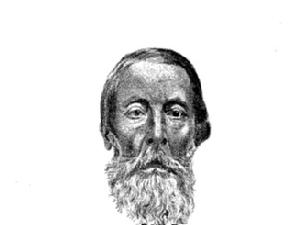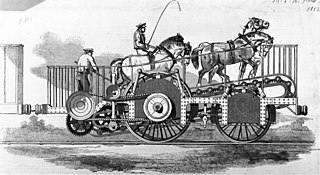
The Rainhill trials was an important competition run from the 6 to 14 October 1829, to test George Stephenson's argument that locomotives would have the best motive power for the then nearly-completed Liverpool and Manchester Railway (L&MR). Ten locomotives were entered, of which five were able to compete, running along a 1 mile (1.6 km) length of level track at Rainhill, in Lancashire.

A train is a series of connected vehicles that run along a railway track and transport people or freight. Trains are typically pulled or pushed by locomotives, though some are self-propelled, such as multiple units or railcars. Passengers and cargo are carried in railroad cars, also known as wagons or carriages. Trains are designed to a certain gauge, or distance between rails. Most trains operate on steel tracks with steel wheels, the low friction of which makes them more efficient than other forms of transport.

The history of rail transport began before the beginning of the common era. It can be divided into several discrete periods defined by the principal means of track material and motive power used.

The Timeline of U.S. Railway History depends upon the definition of a railway, as follows: A means of conveyance of passengers and goods on wheeled vehicles running on rails, also known as tracks.

The Best Friend of Charleston was a steam-powered railroad locomotive widely considered the first locomotive to be built entirely within the United States for revenue service. It was also the first locomotive to suffer a boiler explosion in the United States.

The Southern Railway was a class 1 railroad based in the Southern United States between 1894 and 1982, when it merged with the Norfolk and Western Railway (N&W) to form the Norfolk Southern Railway. The railroad was the product of nearly 150 predecessor lines that were combined, reorganized and recombined beginning in the 1830s, formally becoming the Southern Railway in 1894.
The Flying Dutchman is a legendary ghost ship.

Cycloped was an early horse-powered locomotive, built by Thomas Shaw Brandreth of Liverpool, which competed unsuccessfully in the Rainhill trials of October 1829.

This is a list of the earliest railroads in North America, including various railroad-like precursors to the general modern form of a company or government agency operating locomotive-drawn trains on metal tracks.

Tom Thumb was the first American-built steam locomotive to operate on a common-carrier railroad. It was designed and constructed by Peter Cooper in 1829 to convince owners of the newly formed Baltimore and Ohio Railroad (B&O) to use steam engines; it was not intended to enter revenue service. It is especially remembered as a participant in a legendary race with a horse-drawn car, which the horse won after Tom Thumb suffered a mechanical failure. However, the demonstration was successful, and the railroad committed to the use of steam locomotion and held trials in the following year for a working engine.

The South Carolina Canal and Rail Road Company was a railroad in South Carolina that operated independently from 1830 to 1844. One of the first railroads in North America to be chartered and constructed, it provided the first steam-powered, scheduled passenger train service in the United States.

The South Carolina Rail Road Company was a railroad company that operated in South Carolina from 1843 to 1894, when it was succeeded by the Southern Railway. It was formed in 1844 by the merger of the South Carolina Canal and Rail Road Company (SCC&RR) into the Louisville, Cincinnati and Charleston Railroad Company. It was built with a track gauge of 5 ft.

A predecessor to the Class I Delaware and Hudson Railway, the 1820s-built Delaware and Hudson Canal Company Gravity Railroad('D&H Gravity Railroad') was a historic gravity railroad incorporated and chartered in 1826 with land grant rights in the US state of Pennsylvania as a humble subsidiary of the Delaware and Hudson Canal and it proved to contain the first trackage of the later organized Delaware and Hudson Railroad. It began as the second long U.S. gravity railroad built initially to haul coal to canal boats, was the second railway chartered in the United States after the Mohawk and Hudson Rail Road before even, the Baltimore and Ohio. As a long gravity railway, only the Summit Hill and Mauch Chunk Railroad pre-dated its beginning of operations.
The Leiper Railroad was a 'family business–built' horse drawn railroad of 0.75 miles (1.21 km), constructed in 1810 after the quarry owner, Thomas Leiper, failed to obtain a charter with legal rights-of-way to instead build his desired canal along Crum Creek. The quarry man's 'make-do' railroad was the continent's first chartered railway, first operational non-temporary railway, first well-documented railroad, and first constructed railroad also meant to be permanent.
The credit of constructing the first permanent tramway in America may therefore be rightly given to Thomas Leiper. He was the owner of a fine quarry not far from Philadelphia, and was much concerned to find an easy mode of carrying stone to tide-water. That a railway would accomplish this end he seem to have had no doubt. To test the matter, and at the same time afford a public exhibition of the merits of tramways, he built a temporary track in the yard of the Bull's Head Tavern in Philadelphia. The tramway was some sixty feet long, had a grade of one inch and a half to the yard, and up it, to the amazement of the spectators, one horse used to draw a four-wheeled wagon loaded with a weight of ten thousand pounds. This was the summer of 1809. Before autumn laborers were at work building a railway from the quarry to the nearest landing, a distance of three quarters of a mile. In the spring of 1810 the road began to be used and continued in using during eighteen years.
by John Bach McMaster, page 494, A History of the People of the United States, from the Revolution to the Civil War
The history of rail transport in Great Britain to 1830 covers the period up to the opening of the Liverpool and Manchester Railway, the world's first intercity passenger railway operated solely by steam locomotives. The earliest form of railways, horse-drawn wagonways, originated in Germany in the 16th century. Soon wagonways were also built in Britain. However, the first use of steam locomotives was in Wales. The invention of wrought iron rails, together with Richard Trevithick's pioneering steam locomotive meant that Britain had the first modern railways in the world.

The William Aiken House and Associated Railroad Structures make up a National Historic Landmark District in Charleston, South Carolina, that contains structures of South Carolina Canal and Railroad Company and the home of the company's founder, William Aiken. These structures make up one of the largest collection of surviving pre-Civil War railroad depot facilities in the United States. The district was declared a National Historic Landmark in 1963.

Dr. Andrea Crestadoro (1808–1879) was a bibliographer who became Chief Librarian of Manchester Free Library, 1864–1879. He is credited with being the first person to propose that books could be catalogued by using keywords that did not occur in the title of the book. His ideas also included a metallic balloon, reform of the tax system, and improvements to a railway locomotive – the Impulsoria – that was powered by four horses on a treadmill.

The Impulsoria was a locomotive constructed in 1850 that was powered via a gearbox by one-two to four horses on a treadmill following a design by Clemente Masserano. It undertook trials in London in 1850 and was exhibited at The Great Exhibition in 1851.

















